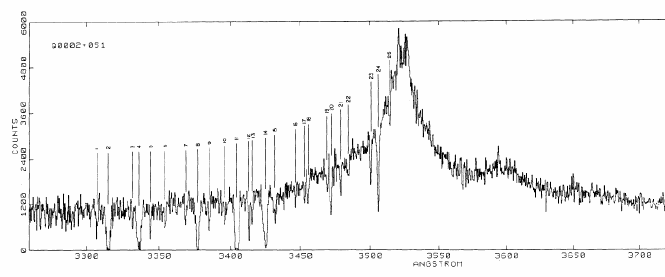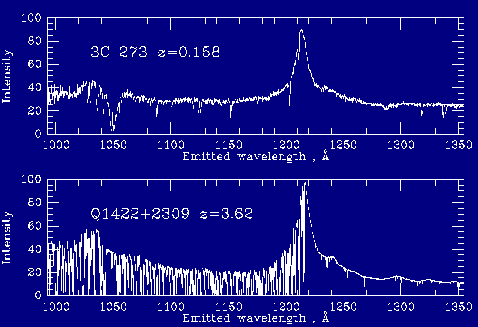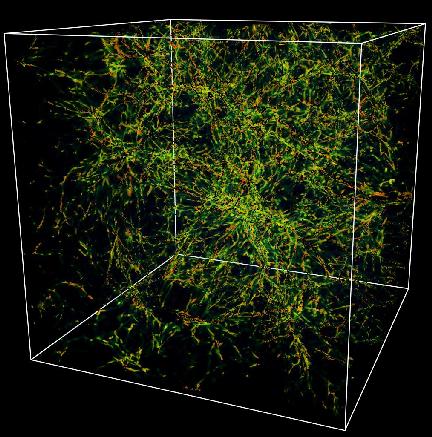The premier test for neutral gas as a component of the IGM is the Gunn-Peterson test (1965 ApJ 142, 1633; see also Shklovskii 1964 Astron. Zh. 41, 408). This uses the mapping between observed frequency and distance to associate continuum absorption shortward of Lyman a in quasar spectra with Lyman a absorption from diffuse matter spread over a wide redshift range. Such absorption is expected to have optical depth

thus a function of z even for constant density, since the mapping between distance interval and redshift interval is nonlinear. Long sought as soon as the region below Lyman a became accessible in quasar spectra, Gunn-Peterson absorption as a continuum has been detected only at redshifts z > 6, where the IGM is almost opaque in the Lyman continuum (Becker et al. 2001 AJ 122, 2850, especially Figure 1). These observations show us the end of the cosmological reionization era, as the neutral medium after recombination was ionized by the first stars and kept that way by quasars down to today. Limits to G-P absorption at z < 6 are at the level of a few percent (Giallongo et al. 1994 ApJL 425, L1). There are plenty of cases of line absorption from multiple discrete clouds or single galaxies, and in fact Lyman edge cutoffs from single galaxies have been seen, but this test gives a strong limit to the overall mass density of neutral hydrogen in the recent Universe: W (H0) < 3 x 10-7. Similar, less stringent limits can be set on molecular matter (Field, Solomon, and Wampler 1966 ApJ 145, 351). Numerous attempts have been made to find 21 cm H I emission from clumped intergalactic matter, including surveys at high redshifts for which 1420 MHz/(1+z) matches available receivers. So far, only a few local clouds mostly associated with low-luminosity dwarfs or interacting galaxies have turned up.
Since the IGM turns out to be hot and therefore highly ionized, with heating sources such as QSOs and star-forming galaxies common in the early Universe, searches have also been made for the He II continuous absorption at high redshifts, since this should be seen for plasmas in which the hydrogen is completely ionized (and therefore produces no ionization edge). Because it may be the dominant ionization stage of helium, and its reasonably large cross-section, He II is in a sense a stronger absorption target than hydrogen in the IGM. This test must be done for high-redshift objects, since the ionization energy goes as Z2 x 13.6 eV; so we must see wavelengths shorter than 228 Å in the QSO emitted frame. Very few QSOs will be suitable background sources for this test, both on luminosity grounds and because most high-redshift QSOs will have their light blocked by a Lyman-limit absorber (galaxy or diffuse cloud) at smaller redshifts. Frantic searches turned up a few candidates, either at z > 2.8 for HST or z > 2.2 for HUT. Jakobsen et al. (1994 Nature 370, 35) reported the detection of an absorption trough in Q0302-003 at z=3.286 with low spectral resolution, with large optical depth t > 3.2 (any larger value is within the error range). This corresponds to a mean density, for fully ionized He with typical "primordial" abundances, WIGM > 2.5 h x 10-5 in the plausible case that He II is the dominant species. However, Songaila, Hu & Cowie (1995 Nature 375, 124) argue that the blended effect of the He II counterparts to Lyman a absorption systems seen at high resolution may be sufficient to account for this absorption without a truly diffuse medium (though note that has shown that in a rich enough velocity field, redshift crowding could create a line spectrum from spatially continuous material; Bi et al. 1992 A&A 266, 1). The onset of the continuous depression is an important point; He II Lyman a starts at 304 Å x (1+z) rather than 228 Å for the ionization edge. The Astro-2 flight of the Hopkins Ultraviolet Telescope, with improved reflective coatings, yielded a long exposure of Q1700+64 at z=2.72, which is perhaps a friendlier target than 0302-003, since at lower redshifts the confusion with cumulative line absorption is smaller. (Davidsen, Kriss, & Zheng 1996 Nature 380, 47). This detection gives t =1.0 ± 0.07 at the He II edge, and the positive flux detection below the edge indicates that the absorption may preferentially come from the lowest-density regions (rather than the discrete Lyman a absorbers). They speculate that the difference between their result and the higher-z Q0302-003 observation, as well as a yet-unpublished measure of t > 1.5 at z=3.1, may reflect real redshift evolution of this component of the IGM. The issue was clarified with STIS observations of Q0302-003 by Heap et al. (2000 ApJ 534, 69), which showed absorption near the QSO consistent with just the counterpart of the Lyman a forest, but an extra diffuse component required at somewhat lower redshifts. The match between H and He lines suggests a change in the spectrum of the overall ionizing radiation field with redshift, hardening rapidly toward lower redshifts between z=3.0 and 2.87. FUSE data confirm that there is a He II Lyman a forest, which become relatively stronger with respect to the hydrogen lines in lower-density regions (Kriss et al. 2001 Science 293, 1112). The longer recombination timescales there would shift the ionization balance upward.
Cold H I should also appear in absorption at 21 cm against distant radio sources, just as Ly a in the Gunn-Peterson test. For absorption by hydrogen at excitation temperature TE, t = 3.4 x 104 nh / TE from which nh/TE < 1.8 x 10-8 cm-3. For emission, we expect the "blank-sky" spectrum to show an asymmetry with respect to the 1420 MHz rest wavelength. Penzias and Wilson (1968 APJLett 153, L7) found that their limits to such emission imply W(H0) < 0.16.
The IGM highly ionized (by collisions or photons). We might detect such an ionized IGM directly by X-ray brehmsstrahlung emission (since it must have a high temperature to avoid rapid cooling to a neutral state). There does in fact exist a diffuse X-ray background, which results from some combination of unresolved individual sources (QSOs, clusters, starbursts,...) and a truly diffuse IGM. Various proposals for fractions of the XRB produced by discrete objects have ranged from 5-300%; there is plenty of scope for new observations at high angular resolution. The X-ray background spectrum does not match that of any known class of object, with a discrete break in slope near 20 keV. Recent deep surveys with Chandra and XMM-Newton have literally resoved the issue, identifying most of the X-ray background with faint discrete sources, and suggesting that the contribution from heavily obscured AGN accounts for the 20 keV break. This leaves very little possible role for IGM emission in X-rays.
The Lyman a forest: All QSOs with redshifts large enough for us to observe shortward of Lyman a (1216 Å) in the QSO frame show numerous sharp absorption features apparently due to the presence of intergalactic clouds absorbing in the strongest hydrogen resonance line. This was reported first by Lynds 1971 (ApJLett 164, L73). Reviews on the Lyman a forest include Sargent and Boksenberg 1983, in Quasars and Gravitational Lenses, proc. 24th Liege Astrophysical Colloquium, p. 518; Weymann, Carswell, and Smith 1981 ARA&A 19, 41; and the chapters by Hunstead, Carswell, and Ostriker in QSO Absorption Lines: Probing the Universe (STScI: Cambridge, 1988).
Do not confuse Lyman a absorption systems with the metal-line systems identified with "normal" intervening galaxies, or with the broad-absorption line systems that are intrinsic to the QSO. A sample of the Lyman a forest is given in Fig. 1 of Young et al. 1982 (ApJ 252, 10, courtesy of the AAS):

The strong broad emission feature is Lyman a at the QSO redshift z=1.899. Identification of the narrow features as the same transition is supported by the gross asymmetry on either side of the emission peak. Note that the density of absorption features changes with redshift (wavelength). Adopting some cosmological model, this gives the time evolution of the absorbers. It is traditional (though by now somewhat misleading) to identify distinct absorption features as physical clouds.
These clouds either are or are imbedded in the IGM. What can we tell about their properties?
Number density: The distribution with equivalent with at fixed redshift is close to a power law in column density. If one counts lines to some fixed limiting equivalent width in spectra of several QSOs and converts to density per cubic Mpc in comoving coordinates (factoring out the (1+z)3 due simply to Hubble expanion), this shows that the density drops toward recent times. The clouds are disappearing. However, they aren't all gone. HST spectra of 3C 273 show seven Lyman a systems at z < 0.15, some perhaps associated with the Virgo complex. From archival HST FOS data and Keck spectra, this plot compares the Lyman a forest at low redshift, for 3C 273, and high, showing the strong evolution of the absorbing population:

Seeing these systems at low redshift allows a reasonable test for matches with galaxies near the QSO line of sight. While the Lyman a clouds vaguely follow the galaxy distribution in redshift, there are not at this point exact matches to material associated with particular galaxies, even dwarfs, and the clouds aren't detectable emitters of Ha. There is strong evidence that the Lyman a lines are underabundant at redshifts close to that of the background quasar, the proximity effect, usually taken to mean that the QSO ionizes all the material within some megaparsecs too highly to see the absorption. This provides a way to estimate the ambient ionizing-radiation intensity as a function of redshift, using the better-known QSO radiation as a point of comparison and seeing how far away it makes a significant difference.
Sizes: (or more precisely correlation scales): look at pairs of QSOs along similar lines of sight, appearing within a few arcseconds as we see them, and count the coincident absorption systems and those that don't match. Gravitational lenses are excellent for this. The few cases for which this is possible suggest a typical dimension of some tens of kiloparsecs.
Mass: the line widths are (just barely) resolvable. Together with a typical size, this was long used to give a virial mass (i.e. assuming gravitationally bound clouds). This comes out extremely large, suggesting nongravitationally bound systems (that is, they are externally confined). The column densities from equivalent widths, compared to these mases, imply that the clouds are almost completely ionized. The H I we see is only a trace constituent of ionized material. However, with what has come out about the spatial and velocity structure of the IGM, it's not at all clear that we can derive useful masses for individual features in this way.
Highly ionized stuctures thus seem to exist in the IGM, which were at one time much more common than bright galaxies. Typical parameters are thought to be T = 3 x 104 K, M ~ 107 solar masses, R ~ 10 kpc, and metal abundances about 10-3 solar (that is, "pregalactic" material). The heavy-element abundance is clearly not zero. There is an O VI forest to match the H and He II forests (Tripp, Savage, and Jenkins 2000 ApJL 534, L1), a major target of this year's FUSE observations. The ionization balance is so poorly constrained that estimates of the metallicity are extremely crude. X-ray absorption measurements of O VI-O VIII work on a few lines of sight, and suggest that the hot and hotter phases of the IGM are major reservoirs of baryons. In fact, more properly, the major reservoirs of baryons. The following table lists some recent consensus values (courtesy of G. Bothun) on the fractions of critical density W contributed by various kinds of (normal) matter.
| Phase | Density fraction |
| All baryons | 0.041 |
| Galaxies | 0.003 ± 0.001 |
| H I | 0.00039-0.00063 |
| Lyman a forest | 0.008-0.012 |
| O VI medium | 0.003-0.008 |
The enrichment of the IGM may go beyond supernova ejecta leaking from galaxies and clusters, back to the first generation of massive stars before galaxy formation proper occurred.
The major development in understanding the Lyman a forest (indeed one that almost halted the traditional field, since it weakened the putative connection between the absorbers and protogalaxies) was the understanding (Cen et al. 1997 ApJL 437, L9 and later papers, Levshakov and Kegel 1998 MNRAS 301, 323) that what look spectroscopically like discrete clouds are a natural result of (initially weak) fluctuations in a low-density gas which is subject to perturbation by density effects, including weak shocks. The ionization state as well as velocity structure (just as in flow-induced redshift distortions of clusters and filaments in the galaxy distribution) will be modulated more strongly than the density field. Some of the effect is seen in this neutral hydrogen density contour from a model by Miralda-Escude et al. (1996 ApJ 471, 582, by permission of the AAS), which also generated very convincing absorption profiles and statistics.

Renyue Cen has an extensive set of simulations available on the Web. As an example, here is a typical perspective view of the H I density in a 25-Mpc comoving cube at z=4 (courtesy of Cen, who gave permission for book usage).

Radio jets and lobes: the existence and structure of radio sources requires some external medium providing a counterpressure, else they would freely expand and become rapidly invisible. General stability and structure considerations allow some limits to be placed on the surrounding medium. Early work includes Rosen and Wiita (1988 ApJ 330, 16); a fuller treatment has been done by Hardee et al. (1992 ApJ 387, 460), with more rapid progress now possible.
Last changes: 10/2006 © 2000-6